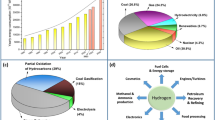Abstract
Hydrogen treatment has been proposed as a simple and effective strategy to enhance the performance of TiO2 nanostructures for applications such as photocatalysis and photoelectrochemical (PEC) water splitting. While some studies have suggested that the black color can be ascribed to surface disorder, other reports have suggested that it is caused by the “oxygen vacancy” states associated with Ti3+ within the bandgap of the TiO2. The chemical nature and potential use of the bandgap states responsible for the black color of increased visible absorption is not yet well understood and subject of strong interest. Here we briefly review current understanding of the possible mechanisms behind the black color of hydrogen-treated TiO2 nanowires and its relevance to photocatalysis and solar water splitting for hydrogen generation. One important conclusion to date is that while hydrogen treatment enhances photocurrent of TiO2 with UV excitation, no noticeable photocurrent can be detected with visible light, which seems to be due to the very short lifetimes of the bandgap oxygen vacancy states arising from hydrogen treatment.
Similar content being viewed by others
References
Fujishima A, Honda K. Electrochemical photolysis of water at a semiconductor electrode. Nature, 1972, 238: 37–38
Linsebigler AL, Lu G, Yates JT. Photocatalysis on TiO2 surfaces: principles, mechanisms, and selected results. Chem Rev, 1995, 95: 735–758
Bak T, Nowotny J, Rekas M, Sorrell CC. Photoelectrochemical properties of the TiO2-Pt system in aqueous solutions. Int J Hydrogen Energy, 2002, 27: 19–26
Biswas S, Hossain MF, Takahashi T. Fabrication of gratzel solar cell with TiO2/CdS bilayer photoelectrode. Thin Solid Films, 2008, 517: 1284–1288
Liu B, Aydil ES. Growth of oriented single-crystalline rutile TiO2 nanorods on transparent conducting substrates for dye-sensitized solar cells. J Am Chem Soc, 2009, 131: 3985–3990
Lin YJ, Zhou S, Liu XH, Sheehan S, Wang DW. TiO2/TiSi2 heterostructures for high-efficiency photoelectrochemical H2O splitting. J Am Chem Soc, 2009, 131: 2772–2773
Fitzmorris RC, Larsen G, Wheeler DA, Zhao Y, Zhang JZ. Ultrafast charge transfer dynamics in polycrystalline CdSe/TiO2 nanorods prepared by oblique angle Co-deposition. J Phys Chem C, 2012, 116: 5033–5041
Baker DR, Kamat PV. Disassembly, reassembly, and photoelectrochemistry of etched TiO2 nanotubes. J Phys Chem C, 2009, 113: 17967–17972
Hensel J, Wang GM, Li Y, Zhang JZ. Synergistic effect of CdSe quantum dot sensitization and nitrogen doping of TiO2 nanostructures for photoelectrochemical solar hydrogen generation. Nano Lett, 2010, 10: 478–483
Asahi R, Morikawa T, Ohwaki T, Aoki K, Taga Y. Visible-light photocatalysis in nitrogen-doped titanium oxides. Science, 2001, 293: 269–271
Liu G, Wang X, Wang L, Chen Z, Li F, Lu GQ, Cheng HM. Drastically enhanced photocatalytic activity in nitrogen doped mesoporous TiO2 with abundant surface states. J Colloid Interf Sci, 2009, 334: 171–175
Li Y, Zhang JZ. Hydrogen generation from photoelectrochemical water splitting based on nanomaterials. Laser Photonics Rev, 2011, 4: 517–528
Doan NM, Estrellan CR, Purnomo A, Gallardo S, Salim C, Hinode H. Characterization and photocatalytic activity of nano-TiO2 doped with iron and niobium for turquoise blue dye removal. Asean J Chem Eng, 2012, 1: 34–41
Ye GX, Wu B, Chen T, Zhang LK, Wang M, Chen L, Liu HL, Huang CR, Li JL. Crystal, electronic and magnetic structure of Co and Ag doped rutile TiO2 from first-principles calculations. Adv Mater Res, 2012, 399: 1789–1792
Zhong M, Shi J, Xiong F, Zhang W, Li C. Enhancement of photo-electrochemical activity of nanocrystalline CdS photoanode by surface modification with TiO2 for hydrogen production and electricity generation. Sol Energy, 2012, 86: 756–763
Chen X, Liu L, Yu PY, Mao SS. Increasing solar absorption for photocatalysis with black hydrogenated titanium dioxide nanocrystals. Science, 2011, 331: 746–750
Wang G, Wang H, Ling Y, Tang Y, Yang X, Fitzmorris RC, Wang C, Zhang JZ, Li Y. Hydrogen-treated TiO2 nanowire arrays for photo-electrochemical water splitting. Nano Lett, 2011, 11: 3026–3033
Wheeler DA, Wang G, Fitzmorris RC, Adams SA, Li Y, Zhang JZ. Ultrafast charge carrier dynamics and photoelectrochemical properties of hydrogen-treated TiO2 nanowire arrays. MRS Proc, 2012, 1387: e04–e07
Chen XB, Liu L, Liu Z, Marcus MA, Wang WC, Oyler NA, Grass ME, Mao BH, Glans PA, Yu PY, Guo JH, Mao SS, Chen XB. Properties of disorder-engineered black titanium dioxide nanoparticles through hydrogenation. Sci Rep, 2013, 3: 1–7
Wheeler DA, Ling YC, Dillon RJ, Fitzmorris RC, Dudzik CG, Zavodivker L, Rajh T, Dimitrijevic NM, Millhauser G, Bardeen C, Li Y, Zhang JZ. Probing the nature of bandgap states in hydrogen-treated TiO2 nanowires. J Phys Chem, 2013, 117: 26821–26830
Li Y, Zhang JZ. Hydrogen generation from photoelectrochemical water splitting based on nanomaterials. Laser Photonics Rev, 2010, 4: 517–528
Cronemeyer DC. Infrared absorption of reduced rutile TiO2 single crystals. Phys Rev, 1959, 113: 1222–1226
Cronemeyer DC, Gilleo MA. The optical absorption and photoconductivity of rutile. Phys Rev, 1951, 82: 975–976
Kim WT, Kim CD, Choi QW. Sub-band-gap photoresponse of TiO2−x thin-film-electrolyte interface. Phys Rev B, 1984, 30: 3625–3628
Mao SS, Shen SH, Guo LJ. Nanomaterials for renewable hydrogen production, storage and utilization. Prog Nat Sci: Mater Int, 2012, 22: 522–534
Kim HS, Kang SH. Effect of hydrogen treatment on anatase TiO2 nanotube arrays for photoelectrochemical water splitting. Bull Korean Chem Soc, 2013, 34: 2067–2072
Cooper JK, Ling Y, Longo C, Li Y, Zhang JZ. Effects of hydrogen treatment and air annealing on ultrafast charge carrier dynamics in ZnO nanowires under in situ photoelectrochemical conditions. J Phys Chem C, 2012, 116: 17360–17368
Wang G, Ling Y, Wang H, Yang X, Wang C, Zhang JZ, Li Y. Hydrogen-treated WO3 nanoflakes show enhanced photostability. Energy Environ Sci, 2012, 5: 6180–6187
Wang G, Ling Y, Lu X, Qian F, Tong X, Zhang JZ, Lordi V, Leao CR, Li Y. Computational and photoelectrochemical study of hydrogenated bismuth vanadate, J Phys Chem C, 2013, 117: 10957–10964
Author information
Authors and Affiliations
Corresponding authors
Rights and permissions
About this article
Cite this article
Yu, P., Zhang, J. Some interesting properties of black hydrogen-treated TiO2 nanowires and their potential application in solar energy conversion. Sci. China Chem. 58, 1810–1815 (2015). https://doi.org/10.1007/s11426-015-5400-3
Received:
Accepted:
Published:
Issue Date:
DOI: https://doi.org/10.1007/s11426-015-5400-3




